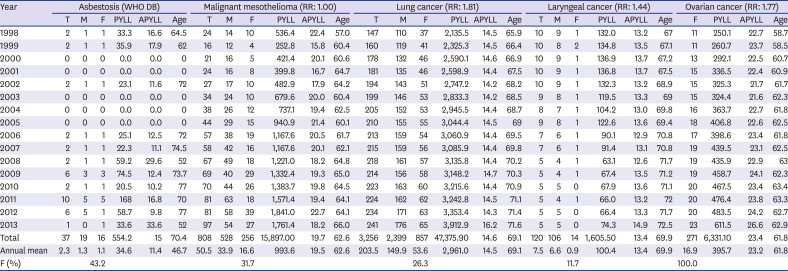1. Kang DM. Health effects of environmental asbestos exposure. J Environ Health Sci. 2009; 35(2):71–77.
4. Driscoll T, Nelson DI, Steenland K, Leigh J, Concha-Barrientos M, Fingerhut M, et al. The global burden of disease due to occupational carcinogens. Am J Ind Med. 2005; 48(6):419–431. PMID:
16299703.
5. Driscoll T, Nelson DI, Steenland K, Leigh J, Concha-Barrientos M, Fingerhut M, et al. The global burden of non-malignant respiratory disease due to occupational airborne exposures. Am J Ind Med. 2005; 48(6):432–445. PMID:
16299701.
6. Diandini R, Takahashi K, Park EK, Jiang Y, Movahed M, Le GV, et al. Potential years of life lost (PYLL) caused by asbestos-related diseases in the world. Am J Ind Med. 2013; 56(9):993–1000. PMID:
23907860.
8. Bang KM, Mazurek JM, Wood JM, Hendricks SA. Diseases attributable to asbestos exposure: years of potential life lost, United States, 1999–2010. Am J Ind Med. 2014; 57(1):38–48. PMID:
24108494.
10. Kang DM, Kim JE, Kim JY, Lee HH, Hwang YS, Kim YK, et al. Environmental asbestos exposure sources in Korea. Int J Occup Environ Health. 2016; 22(4):307–314. PMID:
27726756.
11. Kang DM, Kim JE, Lee YJ, Lee HH, Lee CY, Moon SJ, et al. Environmental health centers for asbestos and their health impact surveys and activities. Ann Occup Environ Med. 2016; 28(1):68. PMID:
27980793.
12. Kang DM, Kim YK, Kim JE. Asbestos and environmental diseases. J Korean Med Assoc. 2012; 55(3):214–222.
13. Kauppinen T, Toikkanen J, Pedersen D, Young R, Ahrens W, Boffetta P, et al. Occupational exposure to carcinogens in the European Union. Occup Environ Med. 2000; 57(1):10–18. PMID:
10711264.
14. Pasetto R, Terracini B, Marsili D, Comba P. Occupational burden of asbestos-related cancer in Argentina, Brazil, Colombia, and Mexico. Ann Glob Health. 2014; 80(4):263–268. PMID:
25459327.
15. Peters CE, Ge CB, Hall AL, Davies HW, Demers PA. CAREX Canada: an enhanced model for assessing occupational carcinogen exposure. Occup Environ Med. 2015; 72(1):64–71. PMID:
24969047.
16. Blanco-Romero LE, Vega LE, Lozano-Chavarría LM, Partanen TJ. CAREX Nicaragua and Panama: worker exposures to carcinogenic substances and pesticides. Int J Occup Environ Health. 2011; 17(3):251–257. PMID:
21905394.
17. Mosavi-Jarrahi A, Mohagheghi MA, Kalaghchi B, Mousavi-Jarrahi Y, Kolahi AA, Noori MK. Estimating the incidence of leukemia attributable to occupational exposure in Iran. Asian Pac J Cancer Prev. 2009; 10(1):67–70. PMID:
19469627.
18. Choi S, Park D, Kim SW, Ha K, Jung H, Yi G, et al. Estimates of the number of workers exposed to diesel engine exhaust in South Korea from 1993 to 2013. Saf Health Work. 2016; 7(4):372–380. PMID:
27924242.
19. Nelson DI, Concha-Barrientos M, Driscoll T, Steenland K, Fingerhut M, Punnett L, et al. The global burden of selected occupational diseases and injury risks: methodology and summary. Am J Ind Med. 2005; 48(6):400–418. PMID:
16299700.
21. Moon EK, Son M, Jin YW, Park S, Lee WJ. Variations of lung cancer risk from asbestos exposure: impact on estimation of population attributable fraction. Ind Health. 2013; 51(1):128–133. PMID:
23269225.
22. Institute of Medicine. Asbestos: Selected Cancers. Washington, D.C.: National Academies Press;2006.
23. Camargo MC, Stayner LT, Straif K, Reina M, Al-Alem U, Demers PA, et al. Occupational exposure to asbestos and ovarian cancer: a meta-analysis. Environ Health Perspect. 2011; 119(9):1211–1217. PMID:
21642044.
26. Kameda T, Takahashi K, Kim R, Jiang Y, Movahed M, Park EK, et al. Asbestos: use, bans and disease burden in Europe. Bull World Health Organ. 2014; 92(11):790–797. PMID:
25378740.
27. Tossavainen A. Global use of asbestos and the incidence of mesothelioma. Int J Occup Environ Health. 2004; 10(1):22–25. PMID:
15070022.
28. Gan WQ, Demers PA, McLeod CB, Koehoorn M. Population-based asbestosis surveillance in British Columbia. Occup Environ Med. 2009; 66(11):766–771. PMID:
19528044.
29. Gong YH, Yoon SJ, Jo MW, Kim A, Kim YA, Yoon J, et al. The burden of cancer in Korea during 2012: findings from a prevalence-based approach. J Korean Med Sci. 2016; 31(Suppl 2):S168–S177. PMID:
27775254.








 PDF
PDF Citation
Citation Print
Print





 XML Download
XML Download